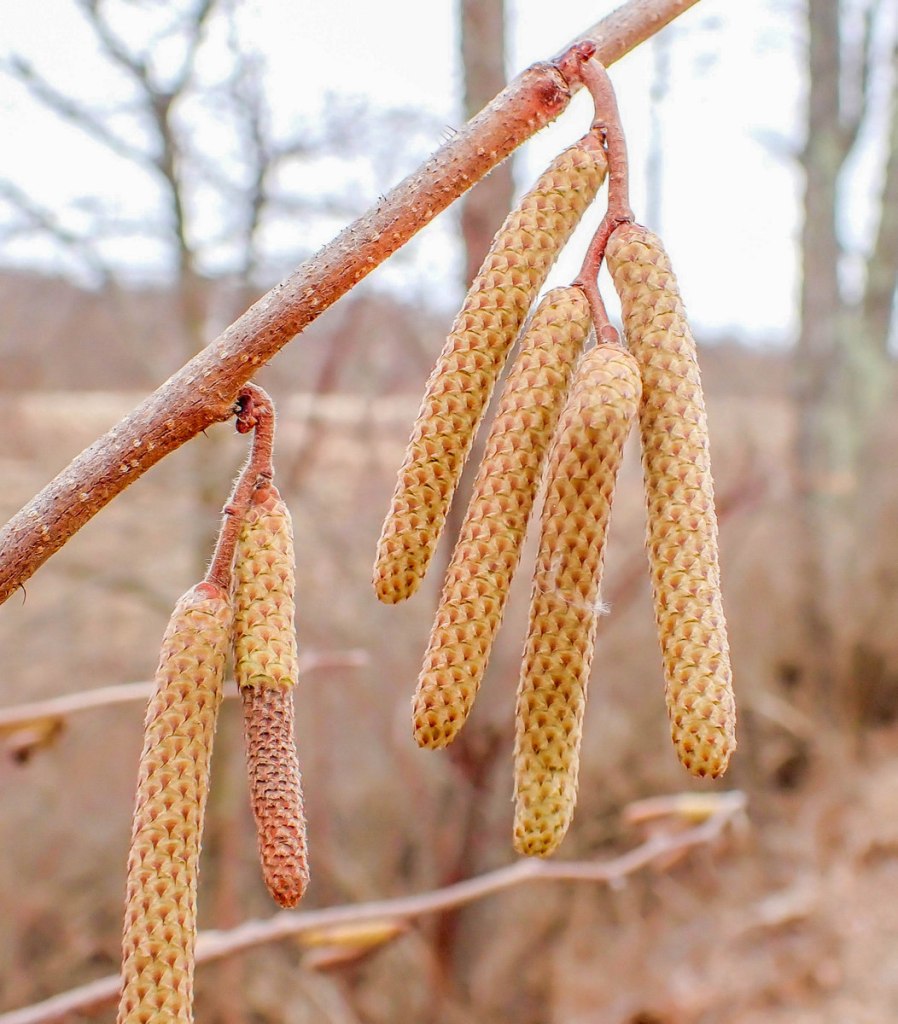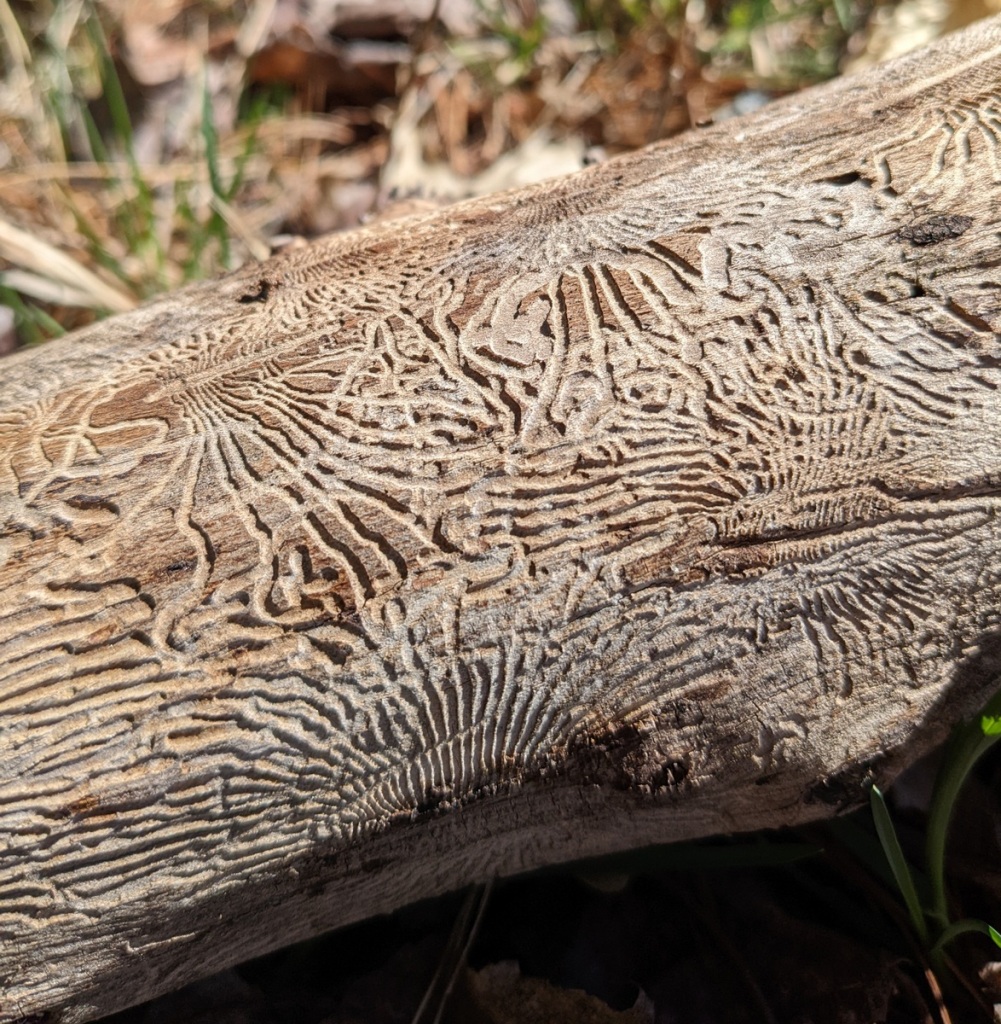
Anyone who has spent time in nature knows that spring doesn’t happen on a certain calendar day. Spring happens when everything seems to just come together one day. The breeze is warmer, the sunshine is warmer, all the birds are singing, insects appear, and people are smiling for no reason they can explain. But even with all these outward signs the first day of spring is sensed more than anything else, and you find that you are finally able to say “this is spring.” That day came last Sunday, March 3rd. One of the outward signs was a beautiful bird song that seemed to be coming from everywhere. I was at the local college and the bird, which I believe was a purple finch, was up in the top of a tree on the corner of one of the large brick buildings surrounding the campus quad. Its warbling song echoed off the brick walls and made it sound like it came from all directions. I think it was enjoying the natural PA system it had found, because even though it saw me with my camera it still sang beautifully.

The purple finch, bird people say, has no purple on it but it does have a color they call “raspberry” on its head, chest, face and back. It’s the New Hampshire State Bird, and it gained that title by edging a chicken out of the top spot. I’d guess whoever named it, if they thought that color was purple, must have been even more colorblind than I am.

The purpose of this day’s outing was to see if I could find any female American hazelnut flowers in bloom. I chose a bush that had male catkins that were golden colored and pliable, signalling that they were almost ready to open and start releasing pollen.

And there were the tiny scarlet stigmas that are the female flowers. I saw several in bloom on this day. The easiest way to find out if they’re ready to bloom is by watching the male catkins. When they turn a gold color the female flowers will be along at any time, because these tiny, sticky red threads are what will catch the pollen that is released on by the male flowers on the golden catkins. If pollination is successful each tiny thread will become a hazelnut.

As I usually do, I’ll show this photo I took years ago to give you a sense of scale. These are some of the smallest flowers I try to get photos of. The only way I can find them is by looking for a hint of color.

While I was looking at the hazelnuts I noticed birds up in the staghord sumacs. They were quite far away and I couldn’t tell what they were, but I had seen flocks of robins here before eating the sumac berries so I assumed that’s what they were. I was surprised, once I started clicking the shutter, to see that they were bluebirds. I believe the one seen here is a female. It’s not a great shot but considering how far away I was on a dim, overcast day I had to be happy with it.

A male bluebird was high up on one of the rungs that climb the towers that hold up the high tension wires in this area. He didn’t have to worry about me following him up there.

Red winged blackbirds have come back in great numbers and for those who have never seen one, this is a classic pose for the males. Males are the only ones with red and yellow shoulder patches. Returning males will sit at the tops of cattail stems to guard the spot they’ve chosen for a nest, and they will fight off any interlopers. Their lives seem to revolve around cattail plants; they use them for cover and build their nests down low to the ground in them. They use their soft fluffy seeds to line the nest and they dig grubs out of last year’s stems. Males will often hide down in the cattails. Their strange whirring, clicking, and whistling calls are the only thing that gives them away. Males will also sit high in the tops of tall trees in large numbers, I found out just the other day.

I’ve never seen the back of a red winged blackbird before. They have some interesting makings.

I took a closer look at a few buds I saw here and there. This Japanese honeysuckle bud was already leafing out, and I wasn’t surprised. That’s one way invasives get a leg up on natives; they start photosynthesizing earlier in spring and later into the fall. It’s common to see Japanese honeysuckles with leaves after most other leaves have fallen.

I didn’t expect to see any movement in beech buds but it’ll soon be time to start watching them for signs of bending. Sunlight excites the cells on the sunlit side of the bud and they grow faster than the cells on the shaded side, and this creates tension in the bud. They slowly curl into a rainbow shaped arc until finally something has to give, and they quite literally tear themselves open. The new leaves just out of the bud are one of the most beautiful things seen in a spring forest but it isn’t just beech; oak, maple, hickory and others are also all beautiful in their own ways. Spring is the time to start watching nature closely if you care about learning anything from it.

Nothing is happening with the brambles like blackberry and raspberry yet but they open quite early so it shouldn’t be too long before they start leafing out.

Last year I saw the beautiful chrome yellow-green buds of bitternut hickory and I told myself I’d go back and see the leaves, but of course I forgot.

This year I’ve written myself a note and stuck it on the refrigerator. SEE BITTERNUT HICKORY LEAVES it says. Whether I see them or not is still a 50/50 chance. The thing about writing notes to yourself is, you can still forget where you put the note.

I took another look look at red maple buds to see how they were coming along. Each one of these buds is just about the size of a BB that you’d put in an air rifle. The one in the middle, just above center, had a hole in it and that meant the bud scales were pulling back to let the flowers out of the bud. Very soon I thought, there will be red and silver maple flowers everywhere.

I went back to the same tree a few days later, after a night of heavy rain, and found that most of the buds had indeed opened and had flowers showing. But I also found many of them filled with water. This illustrates the danger of buds opening too early; if we were to have cold enough weather and the rain water in these buds was to freeze, every flower in the bud, 20-25 of them, would be killed. That’s what bud scales are for; they protect the flower buds inside from getting wet and freezing. If they happen to open too early freezing is a real possibility. We had a freeze in May last spring that wiped out most of the apple crop but by then the maples had done their job and were setting seed.

The vernal pools and wetlands are all free of ice now so I’d guess that the spring peepers will start in any time. They usually start singing just about the time the redwing blackbirds appear.

Willows have yet to flower but the catkins get bigger every day, so it won’t be long.

This is the first scilla of the season that I’ve seen. I think they’re one of the prettiest spring flowering bulbs, especially when massed in the hundreds. I found it in bloom at the local college. Mine aren’t showing yet.

This is the second viola I’ve seen this spring; another college find. I couldn’t get close to it so we could get a better look but there should be many more coming along. I like its color.

Last week I told the story of the lady who asked me about coming to see the locust when what she meant was crocus. This week I was standing on the sidewalk getting shots of these yellow crocus blossoms when a young girl came along with who I would guess must have been her mother and grandmother. “Oh look honey!” the mother said, “The tulips are blooming!” I just smiled and said hello. As John Maxwell said: You cannot overestimate the unimportance of practically everything.

I saw a few reticulated irises at the college, but just a few. There used to be large numbers of them but I suppose they must be fading away with age. Or something. From what I understand the college no longer has a gardener, or someone dedicated to strictly gardening. It’s too bad, because they need one.

These particular reticulated irises are not fading away. In fact they’re increasing and I’m happy about that because they grow in my yard. Last year I had one flower and this year I have four. I have to thank my blogging friend Ginny for them because she sent them up from Maryland. They’re much bigger than those at the college so I’m guessing they must be a hybrid. They’re beautiful whatever they are, so thanks Ginny!
Another thing I’m happy about is daylight savings time begins tonight. I’m all for later sunsets.
It’s spring fever, that’s what the name of it is. And when you’ve got it, you want — oh, you don’t quite know what it is you do want, but it just fairly makes your heart ache, you want it so! ~Mark Twain
Thanks for stopping in.












































